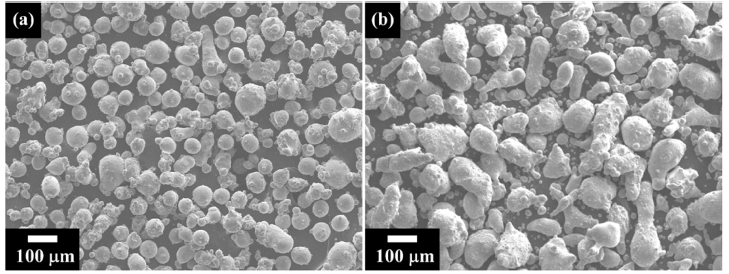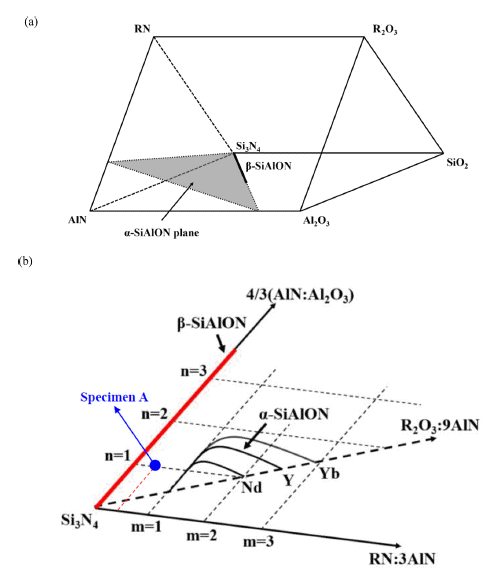Search
- Page Path
- HOME > Search
- [Korean]
- 3D-printing-based Combinatorial Experiment for Al-Si-Cu-Mg Alloys
- Yongwook Song, Jungjoon Kim, Suwon Park, Hyunjoo Choi
- J Powder Mater. 2022;29(3):233-239. Published online June 1, 2022
- DOI: https://doi.org/10.4150/KPMI.2022.29.3.233

- 554 View
- 1 Download
-
 Abstract
Abstract
 PDF
PDF Aluminum alloys are extensively employed in several industries, such as automobile, aerospace, and architecture, owing to their high specific strength and electrical and thermal conductivities. However, to meet the rising industrial demands, aluminum alloys must be designed with both excellent mechanical and thermal properties. Computer-aided alloy design is emerging as a technique for developing novel alloys to overcome these trade-off properties. Thus, the development of a new experimental method for designing alloys with high-throughput confirmation is gaining focus. A new approach that rapidly manufactures aluminum alloys with different compositions is required in the alloy design process. This study proposes a combined approach to rapidly investigate the relationship between the microstructure and properties of aluminum alloys using a direct energy deposition system with a dual-nozzle metal 3D printing process. Two types of aluminum alloy powders (Al-4.99Si-1.05Cu-0.47Mg and Al-7Mg) are employed for the 3D printing-based combined method. Nine types of Al-Si-Cu-Mg alloys are manufactured using the combined method, and the relationship between their microstructures and properties is examined.
- [Korean]
- A Comparative Study on Characteristics of Cutting Tool Materials Based on SiAlON Ceramics
- Seongwon Kim, Jae-Hyung Choi
- J Korean Powder Metall Inst. 2021;28(6):502-508. Published online December 1, 2021
- DOI: https://doi.org/10.4150/KPMI.2021.28.6.502

- 928 View
- 7 Download
- 1 Citations
-
 Abstract
Abstract
 PDF
PDF SiAlON-based ceramics are a type of oxynitride ceramics, which can be used as cutting tools for heatresistant super alloys (HRSAs). These ceramics are derived from Si3N4 ceramics. SiAlON can be densified using gaspressure reactive sintering from mixtures of oxides and nitrides. In this study, we prepare an α-/β-SiAlON ceramic composite with a composition of Yb0.03Y0.10Si10.6Al1.4O1.0N15.0. The structure and mechanical/thermal properties of the densified SiAlON specimen are characterized and compared with those of a commercial SiAlON cutting tool. By observing the crystallographic structures and microstructures, the constituent phases of each SiAlON ceramic, such as α- SiAlON, β-SiAlON, and intergranular phases, are identified. By evaluating the mechanical and thermal properties, the contribution of the constituent phases to these properties is discussed as well.
-
Citations
Citations to this article as recorded by- Preparation and cutting performance of textured SiAlON ceramic brazing composite tool
Run-Ping Liu, Yi Zhou, Yang You, Wei-Ming Guo, Shi-Kuan Sun, Yu-jin Wang, Hua-Tay Lin
Ceramics International.2025; 51(20): 30931. CrossRef
- Preparation and cutting performance of textured SiAlON ceramic brazing composite tool
- [Korean]
- Research Trends of High-entropy Alloys
- Pureunsol Park, Ho Joon Lee, Youngjun Jo, Bonseung Gu, Won June Choi, Jongmin Byun
- J Korean Powder Metall Inst. 2019;26(6):515-527. Published online December 1, 2019
- DOI: https://doi.org/10.4150/KPMI.2019.26.6.515

- 4,637 View
- 37 Download
- 2 Citations
-
 Abstract
Abstract
 PDF
PDF High-entropy alloys (HEAs) are generally defined as solid solutions containing at least 5 constituent elements with concentrations between 5 and 35 atomic percent without the formation of intermetallic compounds. Currently, HEAs receive great attention as promising candidate materials for extreme environments due to their potentially desirable properties that result from their unique structural properties. In this review paper, we aim to introduce HEAs and explain their properties and related research by classifying them into three main categories, namely, mechanical properties, thermal properties, and electrochemical properties. Due to the high demand for structural materials in extreme environments, the mechanical properties of HEAs including strength, hardness, ductility, fatigue, and wear resistance are mainly described. Thermal and electrochemical properties, essential for the application of these alloys as structural materials, are also described.
-
Citations
Citations to this article as recorded by- Composites of equiatomic Y, La, Ce, Nd, and Gd rare earth oxides: Chemical-shift effects and valence spectra
Jungsu Bin, Hyunbae Gee, Taesung Park, UiJun Go, Jeoung Han Kim, Youn-Seoung Lee
Current Applied Physics.2024; 59: 85. CrossRef - Sintering Behavior and Mechanical Property of Transition Metal Carbide-Based Cermets by Spark Plasma Sintering
Jeong-Han Lee, Hyun-Kuk Park, Sung-Kil Hong
Korean Journal of Materials Research.2022; 32(1): 44. CrossRef
- Composites of equiatomic Y, La, Ce, Nd, and Gd rare earth oxides: Chemical-shift effects and valence spectra
- [Korean]
- Sintering Behavior and Thermal Conductivity of Aluminum Nitride Ceramics with MgO–CaO–Al2O3–SiO2 Nano-glass Additive
- Su-Hyun Baik, Kyung Min Kim, Sung-Soo Ryu
- J Korean Powder Metall Inst. 2018;25(5):426-434. Published online October 1, 2018
- DOI: https://doi.org/10.4150/KPMI.2018.25.5.426

- 879 View
- 7 Download
- 1 Citations
-
 Abstract
Abstract
 PDF
PDF In this study, MgO–CaO–Al2O3–SiO2 (MCAS) nanocomposite glass powder having a mean particle size of 50 nm and a specific surface area of 40 m2/g is used as a sintering additive for AlN ceramics. Densification behaviors and thermal properties of AlN with 5 wt% MCAS nano-glass additive are investigated. Dilatometric analysis and isothermal sintering of AlN-5wt% MCAS compact demonstrates that the shrinkage of the AlN specimen increases significantly above 1,300°C via liquid phase sintering of MCAS additive, and complete densification could be achieved after sintering at 1,600°C, which is a reduction in sintering temperature by 200°C compared to conventional AlN-Y2O3 systems. The MCAS glass phase is satisfactorily distributed between AlN particles after sintering at 1,600°C, existing as an amorphous secondary phase. The AlN specimen attained a thermal conductivity of 82.6 W/m·K at 1,600°C.
-
Citations
Citations to this article as recorded by- Effect of MgO-CaO-Al2O3-SiO2 Glass Additive Content on Properties of Aluminum Nitride Ceramics
Kyung Min Kim, Su-Hyun Baik, Sung-Soo Ryu
Journal of Korean Powder Metallurgy Institute.2018; 25(6): 494. CrossRef
- Effect of MgO-CaO-Al2O3-SiO2 Glass Additive Content on Properties of Aluminum Nitride Ceramics
TOP
 KPMI
KPMI


 First
First Prev
Prev


